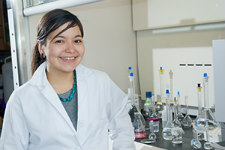Leading Research as an Undergraduate

Ciarra Greene
2012 BS in Chemistry
Hometown: Lewiston, Idaho
Despite having two more years as an undergraduate student at Northern Arizona University, Ciarra Greene is already a highly accomplished researcher. Since her freshman year, for instance, she has been the team leader on a project that seeks to mitigate the negative effects of uranium mines on the Navajo reservation. According to Greene, this kind of experience is rare for an undergraduate student. But, she says, it is has given her valuable experience for whatever comes next.
“I’m the head on the rhamnolipid project—I started on it as a freshman,” says Greene. “The project looks at how biosurfactants can be used to clean up uranium in the soil. I hadn’t thought about it, but Dr. (Jani) Ingram, who has been my mentor, spoke at our chemistry banquet the other week and said, ‘Ciarra took this project on as a freshman.’ Usually there’s a grad student or an upperclassman there to show you the ropes—I didn’t have anyone. I’ve definitely had to do a lot of independent learning on the project, but it’s been really rewarding being the lead on it from the get-go.”
And Greene’s work isn’t just a lab exercise; rhamnolipid biosurfactants have the potential to detoxify massive amounts of uranium contamination. She and her team have been collecting and analyzing soil samples from the nearby Navajo reservation, and are working to understand ways to remove uranium—and the negative effects that it brings to humans and the natural environment—from the soil.
“Right now, all the uranium is getting blown in the dust and into the groundwater; grazing animals are eating the contaminated plants, breathing contaminated air, and drinking contaminated water,” Greene says. “The uranium is not really stabilized in the soil. If you put in a certain amount (of the cleaning agent), what it can do is basically reduce the surface tension of the metal, allowing it to dissolve in water—this process is called leaching. If the leachate or drained liquid can be collected and treated, you can actually remove the uranium from the soil.”
Greene’s work as an undergraduate researcher didn’t happen in a vacuum, though. She says that her time in Flagstaff has brought an invaluable community experience, especially through her participation in the university’s Undergraduate Mentoring in Environmental Biology (UMEB) program. As one of a handful of funded undergraduate researchers, Greene says this program has helped her in many ways.
“(My participation in the UMEB program) has helped me fund and develop my research project now—it pretty much forced me to lay out what I was going to do,” she says. “We’re a pretty diverse group, and everyone brings something different to class each week—not just to always talk about science or our projects, but to take a step back and look at other things in the world. Plus, we’re a really close, tight-knit group; it’s almost like family.”
Greene’s undergraduate career hasn’t just been uranium research, however. She has participated in many academic conferences, and has had opportunities to present her own research. During the school year and summers, Greene also works as an off-site intern through the Nez Perce Tribe’s Environmental Restoration and Waste Management Program (ERWM) and the Department of Energy-Hanford Nuclear Waste Site in Washington (state), where she is able to create educational materials to help all students in the region understand the negative effects stemming from decades of contaminated waste from the Hanford Nuclear Waste Reservation in Richland, WA. And, Greene says, she is a big fan of doing fun things that are specific to Flagstaff.
“I’m from an area about the same size as Flagstaff, but there’s a lot more community involvement here,” she says. “I love how there’s the art walk and activities on the square, and concerts all the time. Back where I’m from, if you don’t have kids who are into sports, there’s really not much to do. In Flagstaff, there are many more options for entertainment. That’s why I like it here so much.”
As she contemplates the future, Greene says, in graduate school, she would like to combine her love of chemistry with her deep sense of allegiance to her tribe. Her goal, she says, is to build on the training she received as an undergraduate student and, ultimately, innovate in order to help people.
“I want to do research on natural roots and medicinal plants that natives use, and do organic chemistry synthesis on those types of molecules, because they have a lot of different properties than over-the-counter medicines,” she says. “I need to talk to more people, more elders, so I can see what they think about it. From my perspective, though, as a scientist and a Native, I can’t see why you wouldn’t want that information shared either way.”
